
Thursday September 08, 2005
Match Up!
NINCO Subaru & Mitsubishi Shoot-Out!
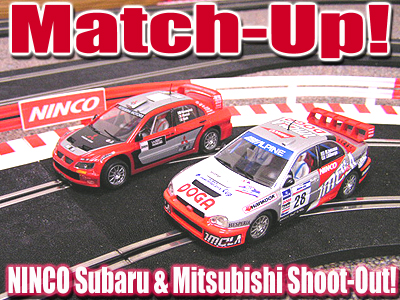 One
nice thing about our hobby today is that it is getting easier to find matching
models for closer racing. NINCO has really stepped up their line-up this year
and these two Rally offerings just sweeten the pot. Both of these releases are
worthy of attention by themselves, but we decided to take both of these hot rods
and see just how well they match up together.
One
nice thing about our hobby today is that it is getting easier to find matching
models for closer racing. NINCO has really stepped up their line-up this year
and these two Rally offerings just sweeten the pot. Both of these releases are
worthy of attention by themselves, but we decided to take both of these hot rods
and see just how well they match up together.
The concept of close, even racing really is not that hard to accomplish anymore. With all the selections we have today it is actually quite simple to start a racing series in your home or club, without the worry of trying to upgrade models to match the performance of one another. I still see people trying to do this, but usually they are trying to match 2 cars that would not truly race each other in the 1:1 world, and then give an unfair judgment, or they are just trying to build a magnet missile.
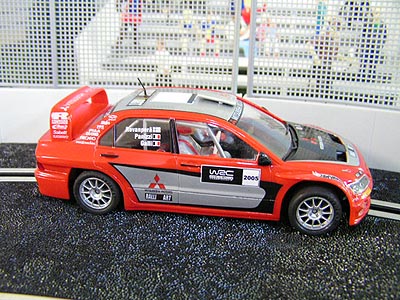
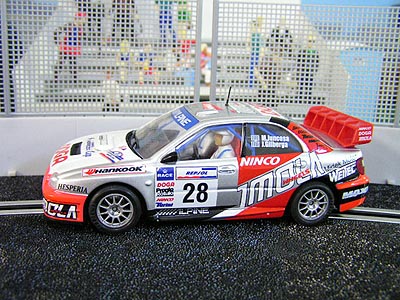
There is nothing wrong with this of course, but I see too many enthusiasts judging a model based more on magnet strength than anything else. NINCO models such as these will not compete against others brands of Rally models that have stronger magnets in them. This fact does not mean you should pass on them. Simply race the NINCO models against themselves and you will find a much more even field.
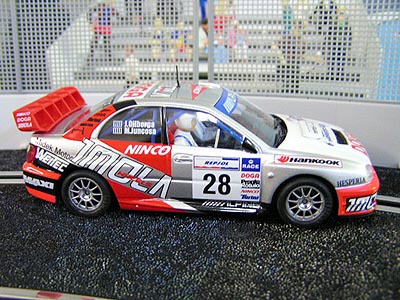
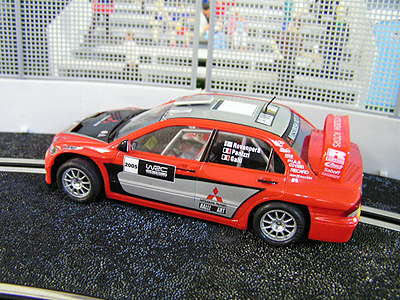
We have looked at some of the Rally models from NINCO before, and quite honestly not much has changed under the hood. However, the detail and paint work by them has increased over the years and these 2 models seem to prove that easily. Both the Imola Subaru that is actually sponsored by NINCO themselves, and the Rally Art Mitsubishi have a level of detail that should please almost anyone in our hobby. NINCO models have received criticism in the past for lack of detail, but these models have a great balance of scale authenticity in my opinion. Sometimes fine scale detail interferes with what these cars are intended for: RACING. I have always thought that NINCO did a fine job of achieving this balance and these models are one of the reasons I still think that way.
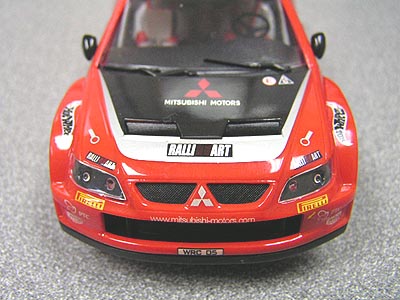
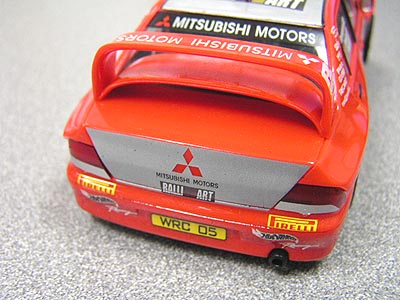
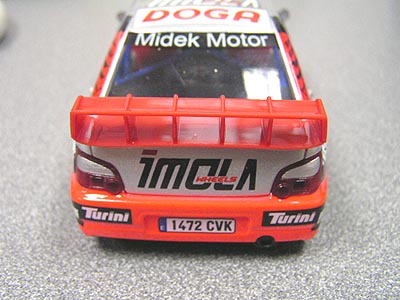
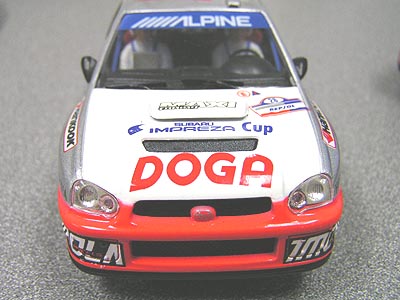
Tampo stampings and paint work on our models were excellent. I found one slight fade on the Subaru, but it is so small it is almost not worth mentioning. Both these models have the standard NINCO half-tray type interior, which regardless what some might say, is more than enough detail for even the particular enthusiast. I say this as both have a co-driver with a chart that you can actually read, plus visible roll cage detail, fire bottle and even Tampo stamped detail to highlight the dash.
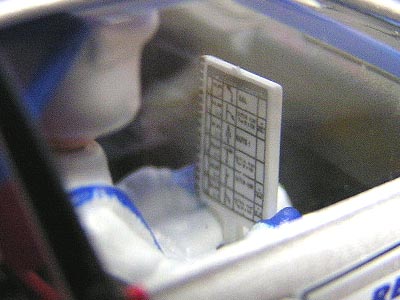
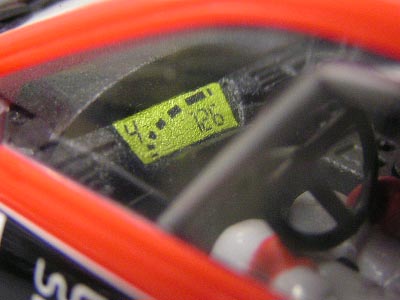
Wheels and tires are also NINCO standard equipment and each is identical to the other. There is brake rotor detail that is visible which increases the scale detail, but the tires are the key. Although many do not think these tires work well, on our NINCO track they perform just fine. They did need some sanding to get them as round as true as I like them, but given the abrasive surface of the NINCO track, even if you skipped this part, after some heavy racing they will be right where they should be. If you choose to sand them, after you are finished just run the tires across some masking tape to clean them up and remove any small chunks of tire.
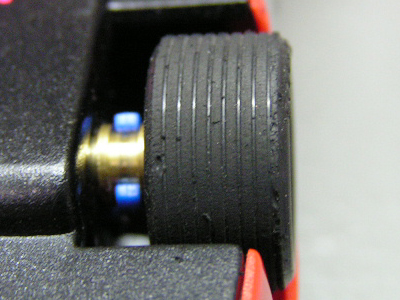
The reason I sand them first is to actually reduce the amount of groove depth on the tires. Although these grooves help the model from sliding out easily, we have found that ease of control is increased if the ribs are lower. This is due to decreasing the "break-away" effect the tires can have. They bite the abrasive track so much that when they do finally give way, your reaction time to control it before it flips or de-slots is marginal. Sanding them before allows a smoother surface on the tire and reduces the amount of bite. After sanding, even in the tight corners the models seem to "telegraph" a little more that you are pushing it too hard and gives you more time to recover.
However, before you sand the tires you might want to try another tune-up.
Some of the more advanced enthusiasts look even closer. On many of our models found today, the problem with some plastic wheels is not that they are out of round, but that the tire is not seated correctly on the wheel. However, sometimes it is the inner rib of the wheel itself that is the problem as some excess flash molding will be present, hence preventing the tire from sitting true.
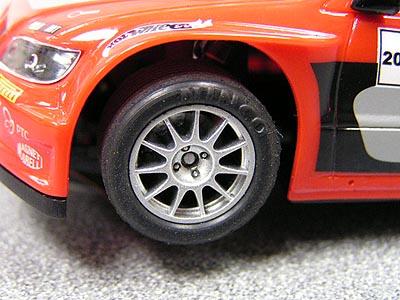
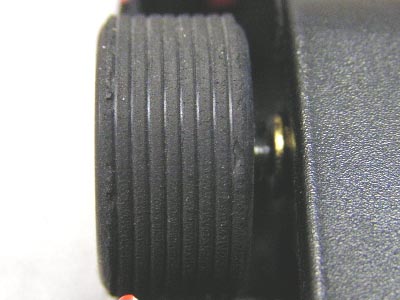
The easiest way we have found to cure this issue is with a simple 9 volt battery and a sanding barrel from any moto-tool. Simply remove the tires from the wheels and touch the 9 volt battery ends to the braids. We show you how HERE. The car will begin to run and you can then take the sanding barrel and apply it to the wheel.
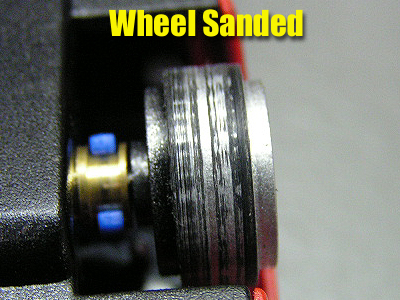
You can quickly see that the barrel is sanding the outer edges of the wheel. It usually only takes a few seconds for each wheel to get them cleaned up and ready for a better tire fit. Once you have completed this, simply put the tires back on the wheels and you are ready for action.
Taking A Look Inside
There are differences in these models, but not enough to make them largely mismatched. NINCO decided to outfit the Mitsubishi with the Pro-Shock suspension while the Subie is standard. I have stated before that I just do not see any reason for these shocks and this match-up proves it. The suspension on the Mitsubishi does not make it handle any better in the corners that then Subaru. In fact, it introduces body roll to the model which just makes it slightly more prone to tipping that it's standard counterpart.
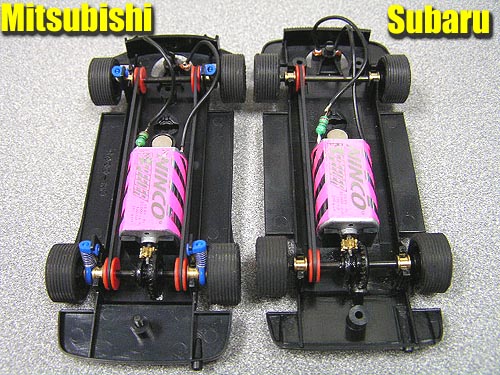
However, it is not that much of an issue. The reason why is that the amount of travel the shocks have is not that great, which is why I think they should not even been applied to the model. Since both these models would obviously be designed to race against each other, NINCO should not have outfitted one and not the other. Regardless of the shock system however, these cars are nicely matched in every other aspect.
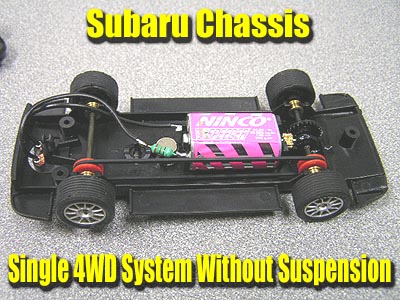
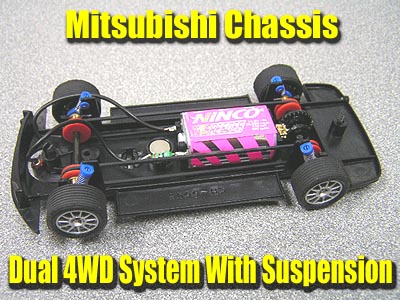
Inside we find the now standard NINCO NC-5 Speeder motor rated at 20,000 RPMs equipped with a 9 tooth brass pinion that drives a 27 tooth plastic crown gear. We also see the standard button magnet placed right where it should be in the mid to front chassis position. This magnet, and the position of it is one of the strong points of the NINCO models in my opinion. While other model makers are surging toward heavy bar magnets and more powerful motors, NINCO is still making these models that not only hold the track well, but forces you to LEARN to drive a slot car. I still prefer the milder NC-2 that was for years the standard for them, but the fact that these models are 4 wheel drive seems to tame the hotter Speeder motor down a little and helps increase the overall control of them.
I want to remind the reader that my tests of these models are based directly towards the home racer. The models are tested on our modest NINCO home layout which can fit in an average sized spare room. How the model operates on a wooden or commercial track I cannot say. These models are designed for use on plastic track and thus our tests will be conducted there. We did test them on other brands of plastic track that we have in our shop to test how they performed on longer straights, but primarily our findings are based on NINCO track.
The 4 wheel drive system does work of course, but opinions of performance vary. However, we race our models almost 100% boxstock. This means that we try and use cars that are similar to these for finding a closer match for racing. It all will come down to your driving preferences on whether or not you will want to keep the 4WD system in place. For this review, we left it in place and I can honestly say that it did not take away from the fun factor of these models.
The Mitsubishi comes equipped with a dual 4WD system, while the Subaru is a standard single pulley. On very long straights the Subaru does have a slight advantage simply due to having less drag on the motor. However, on our NINCO test track that is designed as a small to medium home layout, the difference is virtually non-existent. The best part is that you can simply remove one of the belts on the Mitsubishi if your track has longer straights and this should even things up nicely.
Operation out of the box is exactly what it should be: Problem Free. Although NINCO models take some time to break in and quiet down, both ran quite well with decent gear mesh and no signs of bushings spinning in the chassis. I still advise gluing the bushings in place on the Subaru, but my model showed no signs of movement under a load.
Here Is The True Test Of These Models.
I have had these models for almost a month before I decided to write this review. Why? Because I wanted to subject these cars to a variety of drivers and see how well they held up in the durability department, but also to attain a wider spectrum of opinions.
You might think that younger drivers would find them "harder" to control since they do not have a large magnet in them to keep them planted on the track. Untrue. We have seen over 10 children ranging in ages from 6 years old to 14 race these cars and after a few laps, they simply got used to how they drove and adjusted themselves to them. In fact, ALL of the racers that were in their teens stated that they liked the challenge the models provided. Even the younger competitors had fun beating these cars around the layout, and some of them gave us "old timers" a run for our money!
Aside from cleaning the braids as you normally would, these models have held up to some amazing punishment. Even the antennae on top of each model is still intact although they have been bent and rolled over on many times. The rear wing on the Subie has been knocked off more than once, but you simply pop it right back in place and keep racing. Even the paint, or rather the clear-coat deserves mentioning as it has shown only slight scratches yet has preserved the smaller Tampo stampings just as it was intended to do. I have witnessed both of these models literally slamming into each other at high speeds and each have walked away.
With no modifications done to either car, the Subaru has a very slight advantage. Since it has less body roll due to not having the suspension, you can just dive into and exit the tighter corners a little faster. Bear in mind though that most racers here simply felt they were an excellent match.
Lap times told the tale as both could post averages of 5.4 seconds. The Subaru did manage a 5.2 at times and the Mitsubishi was near that with 5.3. However, the most important factor was of course the DRIVER. A few racers seemed to prefer the Mitsubishi and could have the advantage over the Subaru. I was victim to this very thing as one of my regular racers continually beat me. It took me some time to clean up my driving before I could compete.
Final Adjustments
There are a couple items you can do to slightly improve handling in both models. On the Mitsubishi I simply used hot glue and sealed the suspension. This helped the body roll effect and gave the car a more solid feel in the corners. I also decided to remove one side of the 4WD system to make them an even closer match for long straights.
The Subaru has the same issue with the front axle that many NINCO models have: Excess free-play. The front axle is just too long and causes the front end to shift just a little too much for my tastes in the corners. The fix is simple however as all I did was remove one of the front wheels and using a standard cut-off disc in my moto-tool, trimmed a slight amount off the axle.
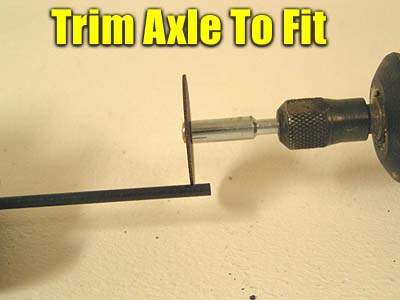
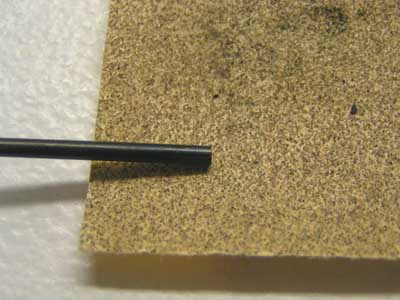
After cutting the axle, just take it and sand it lightly on sandpaper to make sure there are no burs from cutting as shown in the above photo. Then just install the wheel and check your free-play distance. Once this is completed, I had to glue the front bushings in place because they were spinning under load. I did this because since it is 4WD, in time the brass bushings will start to wear away at the plastic chassis.
Non-Magnet
Removing the magnet does drastically change these models. The Speeder motor combined with the higher voltage of the NINCO transformer makes them a handful in the corners for some of our drivers. Adding some sheet lead to the bottom of the chassis gave me a much better handling model, but your personal tuning preference might be different. With the lead added, the car had better control through the turns as I could slide the model out much further and it minimized the tipping effect.
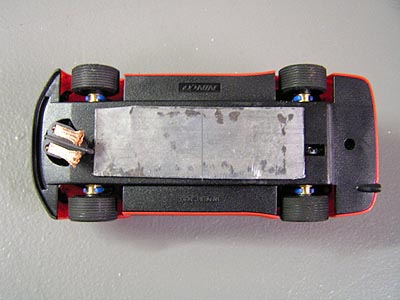
I added just a touch over 0.8 of an ounce of sheet lead as shown. This brought the overall weight of the model to 3.8 ounces. You can add more or less to suit your current layout, but this is what did the trick for me here. I used JK part # 9153 that has an adhesive backing that is .016 thick and comes in 3" by 3" pieces.
Verdict?
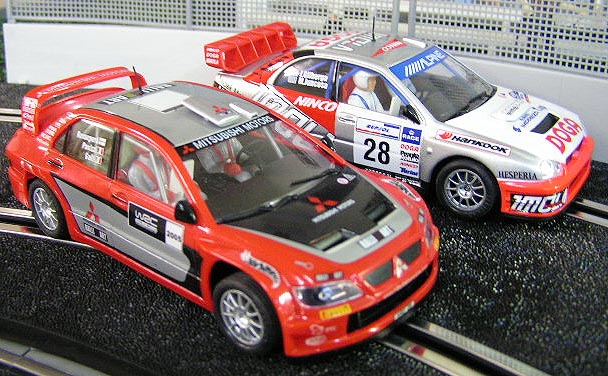
In the end both of these models are winners in their own right. I feel they both represent the 1:1 prototype very well and have an excellent level of detail and overall finish along with good out of the box performance. Although there are slight differences under the hood, these models should find a good home in your Rally-based series.
- Harry
As always feel free to contact me about this article or just the hobby in general at harry@homeracingworld.com, or better yet drop into our Message Forum and share your thoughts with other enthusiasts!
Models Tested Are The #50394 Mitsubishi WRC "Showcar 2005" and #50385 Subaru "Imola 2005"
Thanks Go To MRC For Providing Us With These Models!